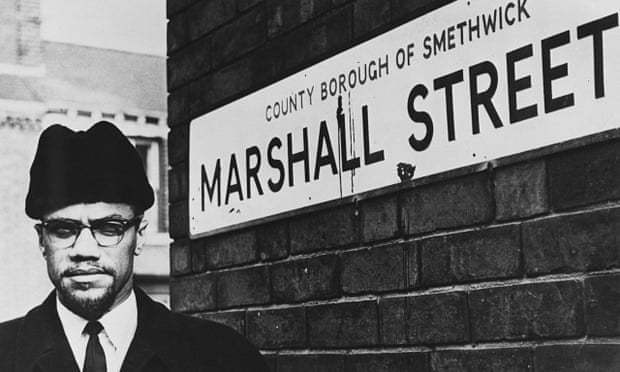BLACK HISTORY FIGURES: Malcolm X

By Fakhriya M. Suleiman, MA Global Media and Communications
My first encounter with Malcolm X was during secondary school. It was Black History Month of 2010 and my history assignment was to write about a prominent Black historical figure and discuss their impact. Being a huge Michael Jackson fan, and since he had only just passed away the year prior, I initially set out to do my report on him, his groundbreaking achievements, and his influence on the entertainment industry.
‘You should write about Malcolm X instead’, my mother remarked when I told her about my plan. Up until that point, Malcolm X was a name I had not heard of. ‘Hop to it!’, my mother went on, ushering me to go and do my research.
I scoured the internet to find out about this figure who had eluded me all this time. I discovered that he was an African American who strove to shatter the staunch barriers of American Jim Crow laws and dismantle its farcical mantra that Blacks were recipients of ‘separate, but equal treatment’. His was an endeavour that also hoped to bring to the forefront the issues of racism on both sides of the Atlantic. The 1964 British General Election, for example, was later dubbed by The Guardian as being ‘Britain’s most racist election’ after Conservative MP, Peter Griffiths, won his Smethwick seat with the slogan ‘If you want a n—– for a neighbour, vote Liberal or Labour’. In solidarity, Malcolm X travelled to Smethwick that same year due to being ‘disturbed by reports that coloured people in Smethwick [were] being badly treated’ amid Griffiths’ plans to prevent the sale of homes to local Black families. Furthermore, the likes of Professor Seyyed Hossein Nasr and Professor Richard Brent Turner credit Malcolm for being pivotal in the spread of Islam among America’s Black communities. Professor Nasr cites that in the spread of mainstream Islam following his departure from the Nation of Islam (NOI) movement, ‘Malcolm X was of particular significance.’
Given the above, and as a member of Britain’s Black Muslim diaspora, it was a puzzlement that I, and most likely my fellow members of the community, had not been taught about such an individual who could have served as a much needed role model to us early on. On the bright side of things, after marking my report, my History teacher gave me an A*.
Fast forward to 2011. I was in my final year of secondary school and had chosen History as one of my GCSE subjects. I was delighted when I found out the 1960s African American Civil Rights Movement was included in our syllabus and I assumed I would have plenty of airtime to impress my classmates with all the Malcolm X trivia I had amassed. However, much to my dismay, when browsing through the textbook, mention of Malcolm therein was no more than a mere paragraph. Said paragraph pitted him against the exemplar of Martin Luther King Junior’s tact of non-violence, framing Malcolm as a hindrance to the African American struggle for civil rights.
Once again, I was left puzzled. While my GCSE History textbook was presented as being the key source to my success, containing the important aspects needed for me to succeed in my eventual final exam, a huge chunk of the narrative was woefully disregarded. My textbook charged Malcolm X with advocating indiscriminate violence against white people as a whole given his once strong affiliation with the NOI movement during the early years of his activism. While the NOI was a separatist movement that did, and still does, preach an ideology of Black supremacy – which Malcolm X did subscribe to, it is oft seldom told how his ideology altered after his split from the movement and his return to America in 1964 after making the Hajj pilgrimage to Mecca. In Birmingham, following his visit to Smethwick, when asked about MP Griffiths Malcolm X wholly refuted NOI ideology by saying ‘the worst form of human being is one who judges another by the colour of his skin’.
My textbook may have also been alluding to Malcolm’s assertion that Black Americans should exercise their Second Amendment Right to bear arms. While he knew stressing upon said Right would render him a pariah within the Civil Rights movement, he chose not to stand mute while Blacks were the perpetual recipients of state-violence. My textbook was not able to specify an instance where Malcolm X was the violent aggressor. Tragically, however, such is still assumed of Black men, and, in 2016, Philando Castile, a Black man legally carrying a concealed weapon, was shot dead by police in Minnesota for no other reason than being armed.
Given the recent turbulent summer of protests sparked by the killing of George Floyd, the call of Malcolm X for us all to ‘one day meet together in the light of understanding’ could not be more germane. Admittedly, I do lament over whether much has truly changed since I was in secondary school writing about Malcolm’s struggle for the betterment of his people.
It is a shame that the mainstream portrayal of Dr King and Malcolm X has been reduced so much that the former is celebrated while the latter is fled from, almost shunned completely. Even though, as pointed out by African American novelist and activist James Baldwin, ‘by the time each died, their positions had become virtually the same position’. Despite this, 10 years on from my initial encounter, Malcolm X remains a figure I hold in the highest regard for his courage and sacrifices. His is a name and legacy I hope history will do the same for, too, ‘by any means necessary’.
Photo Caption: Malcolm X visiting Smethwick in February 1965, just months after the General Election. Credit: Express/Getty Images.



